If we are to truly reimagine the place of shit in our lives, we need to consider the harsh realities of who gets to shit in peace, and who gets to clean it up afterwards.
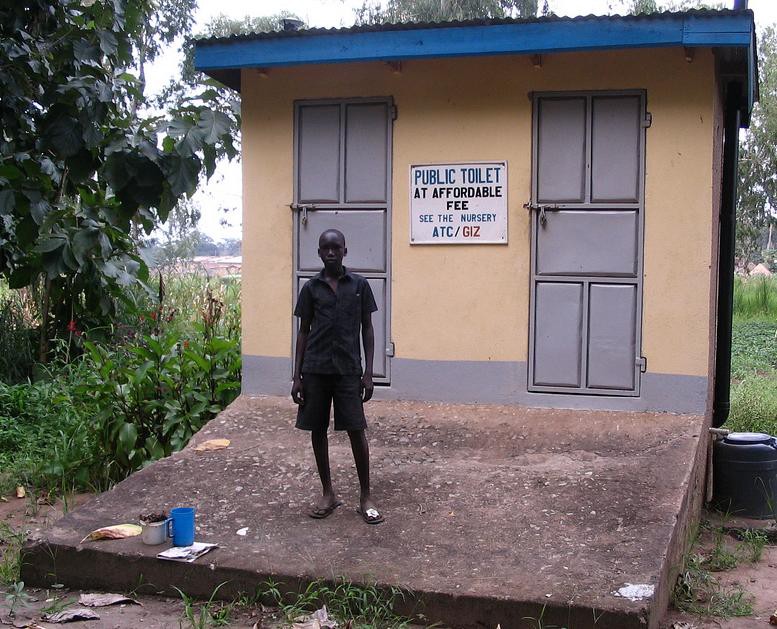
Toilet in Uganda, by Sustainable Sanitation.
Originally published in (the late lamented) The Awl, October 30, 2013
1. THIS SHIT IS REAL
My hand stayed on the bathroom door handle, unwilling to twist the knob that would let me in. Behind me was the hum and chatter of an art opening — this was at a now sadly departed radical Chicago cultural center called Mess Hall. On a table nearby were offerings of hummus and home-made brownies. Nearly everyone else was chatting and oblivious to my plight, but I could sense at least one other person impatiently waiting behind me. Then I went in, and, inside, next to a perfectly serviceable modern flush toilet seat, was a five-gallon bucket of shit. As far as I could tell — I’ll admit I kept my eyes averted — there was a layer of sandy material on the very top of the bucket, along with a note about how to use it. It was like a giant human litter box.
I was happy that they at least gave us a choice, between the loo and the litter.
Follow your shit, we were admonished in this project, and see how it’s all wrapped up in capitalism and the environment. The point was to get us to actually think of what happened to our shit once it left our body, and the ways in which we allow our shit to leave and mingle with the great waters of seas and rivers. The shit compost bucket was a way to make its materiality even clearer, in case we had forgotten.
And we have, by and large, been allowed to forget about shit. We believe that the problem of excrement is solved. In some senses it is, and a society with working waste removal is a healthy society.
Now a number of factions believe that we have gotten too far from shit. They believe we are neglecting “more natural” ways of dealing with shit.
I live in Chicago’s Uptown, and the event was in Rogers Park, north of where I live. Both neighborhoods are known for being home to a mostly white population of lefty-liberals who take somewhat smug pride, in the country’s most racist city, in being a haven for supposed left politics. Some of this reputation is justified, but mostly it belongs to the past. A lot of the lefty-prog gatherings like the one I was at are almost entirely white.
I happen to not be white, and I’m also not from the area. I was born in India, in Calcutta, before it became Kolkata, and I spent a good chunk of my life between that city, Bombay (now Mumbai) and Kathmandu, in Nepal, before making my way to the U.S for graduate studies in 1989.
Scan through any websites about traveling in India, and the subcontinent’s lack of toilets and, in many places, even basic sewage systems, is the most frequently discussed topic. Shit is literally everywhere, and when I was growing up it wasn’t uncommon to have to make one’s way through the evidence of bodies having shat nearby or, for that matter, actually shitting near one because there was simply no place for privacy or dignity.
The very idea that one should be concerned about privacy or dignity while shitting is one that hippy-radicals and academics mock. Historians of shit like to describe this urge to privacy as a bad departure for the culture. Some describe, with a smugness that sometimes floats to the surface, the fact that the ritual of going to the toilet was once upon a time a communal experience, with people laughing and chatting away and catching up on gossip as they went about their business.
Dominique Laporte’s 1978 History of Shit, for instance, interrogated shit as a reservoir of cultural anxieties and asserted that the development of modern toilets was symbolic of a larger bourgeoisification of culture.
Laporte’s is one of the better-known treatises on a taboo subject, also taken up by Julia Kristeva in Powers of Horror: An Essay on Abjection. As might be expected, Slavoj Žižek has a typically Žižekian take on the matter, speculating that the particular shapes of toilet bowls in different countries reflect the ways they relate to philosophical undertakings.
Works like David Waltner-Toews’s The Origin of Feces and Rose George’s The Big Necessity consider the materiality of shit, its composition, its meanings, its expulsions and, mostly, what to do with the vast amounts generated every day on a planet where fewer can actually afford to live somewhere where they’re not often compelled to be face to face with it.
I grew up in a household with unimpeded access to a modern loo, and I traveled in circumstances and circles where I rarely, if ever, had to worry about such. But even I couldn’t escape the immensity of shit and the knowledge that millions around me, in cities teeming with millions when they were built to only sustain perhaps hundreds of thousands, had no access to basic sewage or toilets. India is famous for a lot of things; its general and literal shittiness is one of them.
2. THE WAR ON TOILETS
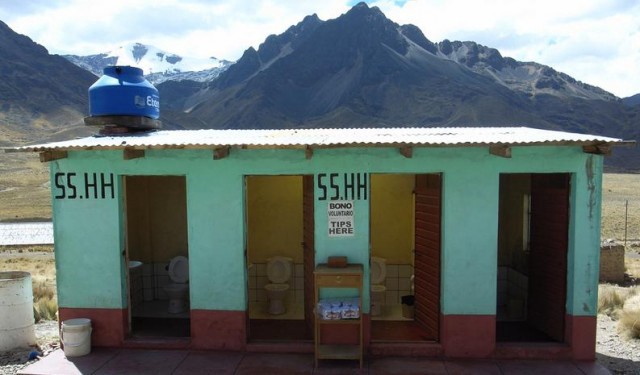
Toilet in Peru, by Nicolas Nova.
There is a logic to the arguments of those who believe we have gotten too far from shit. Civilization, we are told, produces too much shit, and we cannot actually shit less. But there is more human and animal excrement than we can handle. Animal shit particularly has increased exponentially in countries like the U.S., where farming now means animals are herded in the millions as part of massive agribusiness corporations — and the nature of animal shit has changed as animal feed has changed.
So the composters come forth. They believe that to compost shit, to return it to the earth so that it might regenerate the world, addresses our environmental and ecological crisis.
An easy parallel might be found in what is now the big business of green housing. Solutions to energy production take the form of individual acts, like buying the newer (and quite ugly) light bulbs in an effort to conserve energy, or in households literally buying energy units. Yet the Chief Priests of Eco-Politics, such as Al Gore, who boasts about his carbon footprint, really shouldn’t be living in multiple-room mansions in the first place. His air travel footprint dwarfs that of your lightbulb use. As well, spending massive amounts of research and development money on “green cars” pales in contrast to repairing the broken down public transit systems in this country — systems that could transport more people at less cost. The pro-compost society suffers from the same flaws.
Get a bucket, we’re admonished, some sand, and turn it all over every now and then and voila, you’re taking care of the environment.
The flush toilet has transformed lives for millions but it continues to be derided as a wasteful, almost evil, part of modern life. The charges seem unfair to a portal that makes lives easier for so many — there is nothing like a temporarily dysfunctional one to remind you of the necessary part it plays in life.
Last year, the Skeptical Third World Kid meme became a way to communicate an ambivalence about the kind of economic privilege embedded in cultural and economic exchanges between Americans and the brown and black subjects they encountered elsewhere. One in particular referenced the toilet.

This is ambivalent — the child could well be delighted at the prospect of having such an appliance. More obviously it reads as mocking our waste of water. In this way, it ties into the current mania for believing that wasting water is unwarranted, even and especially when it comes to shitting (most compost toilets are dry, and you’re exposed to the sight of other people’s waste).
The toilet industry has been plagued so often by these charges of water waste that it went about creating low-flow toilets. The Energy Policy Act mandated low-flow toilets for residential buildings as of 1994. Since then, there have been efforts at repeal. (As my landlord said when he came to fix my slow-and-low flowing loo, “The one thing that everyone, even lawmakers, has to do is go to the bathroom.”)
But the toilet still functions under a cloud of suspicion, blamed for the waste of water which could, presumably, be used for other matters, like watering a fig tree in one’s yard, under which one might have also placed the nourishing placenta of one’s first-born in order to complete the circle of life.
The toilet is also increasingly blamed for not being ergonomic enough. It’s not enough that it allows us to simply sit, shit, and leave: a growing conversation around the standard toilet is that it is, horrors, much too comfortable and has taken us away from what many profess is the more natural squatting style.
Detailed anatomical diagrams explain the complicated ways this works, involving something called the anorectal angle which supposedly allows shit to leave the body quicker and even lessens hemorrhoids.
As with so many eco-primitivist assumptions, the virtues of the squatting toilet occlude the very real problems for many, particularly the aged and the infirm who find it difficult to engage in the squatting posture. Furthermore, there’s no real science on whether or not squatting is good for you — broad claims are made that populations that squat are free of colon cancer, but there are other factors to consider as well. The average American diet is radically different from that found in the regions — mostly poor, often rural — where squatting is perforce more common. And, as anyone who has actually used one can tell you, squatting toilets require balance — well nigh impossible in boots or heels, are often mysteriously wet (and not with water), and a slip could potentially leave you stuck.
In Japan, where bidet toilets now occupy about 3 in 4 home bathrooms, replacing the common floor-scoop toilet style, the rationale for their design is that the population is aging.
In the annals of shit, it’s not just the dumping of shit but the accoutrements as it were that have come under attack.
Toilet paper, for instance, is blamed as being un-eco-friendly, no matter how much effort goes into making it out of recyclable material. In an article that was a precursor to self-described “guilty liberal” Colin Beavan’s book No Impact Man, the New York Times described a visit to an apartment where the couple had committed to a life of almost no shopping and the most eco-friendly lifestyle possible — one that involved the elimination of toilet paper: “A visitor avoided the bathroom because she knew she would find no toilet paper there.”
Instead, Beavan’s family used “bowls of water” and much air-drying (even laundry, apparently was kept to a minimum).
But toilet paper is especially preferable in any situation, and particularly when — as in many bathrooms — there is, mysteriously, no soap to be found: in such cases it can be at least one protective layer, not to mention that it allows you to avoid the unpleasant sensation of being in close contact with your recently evacuated anus.
3. THE WAR ON DIAPERS
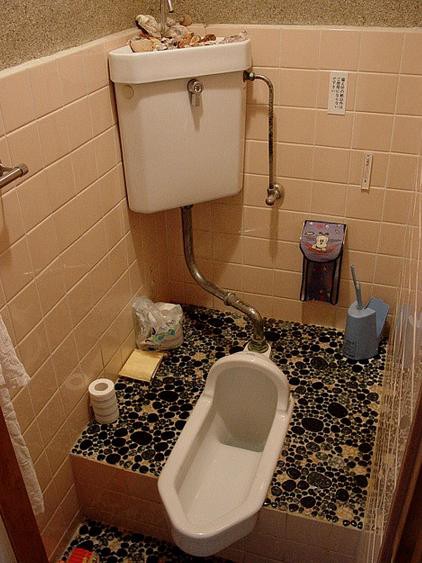
Toilet in Tanabe, Japan, by Tim Notari.
In comfortable communities, there’s an absurd but growing mini-movement to even scrub shit of its shit. Enter the diaper-less movement, cloaked in the clinical-sounding “elimination communication” method.
The movement sees a resurgence every few years, and is especially popular amongst those of a certain class and/or those who have determined that a child’s needs are to be met above all else and, most tellingly, that a child should be attended to hand and foot by a parent whose sole function is to monitor its every bodily function.
According to the gospel of elimination communication, children can be taught from the start to let parents know when they need to use the loo. Parents use bowls, sinks or toilets to collect their childrens’ excrement. Part of the logic, a profoundly neo-primitivist one, is that ancient cultures and civilizations never used or don’t use diapers. This, of course, takes no heed of the fact that perhaps the presence of Pampers, like those of in-house flush toilets, might in fact be a welcome addition to beleaguered parents everywhere.
In response to objections about hygiene — numerous reports abound of people using their friends’ kitchen sinks or bathroom sinks to assist in said “elimination” — parents will insist that shit and any bacteria can easily be cleaned away with soap and water.
To all of that, onlookers might simply ask, as bemused hosts should: “Why should we even have to do that in the first place?”
To start with, the fear of disease is hardly unreal, and to clean a sink or even a shit-smattered toilet bowl of fecal matter requires additional labor and tools on the part of the person doing the cleaning. A kitchen or bathroom sink requires different kinds of cleaning rituals and materials from those required for toilets and, really, just, why? Some argue that it makes little sense to have a baby’s bottom remain in contact with shit for as long as some diapers allow, but surely this temporary situation is a small pay-off for hours of worry-free child-rearing that allow a parent to take time off to do things other than scrutinize a child’s bum.
It’s also worth asking how we are to maintain such assiduously diaper-free existences in, for instance, day cares. The answer, one suspects, is that these are the children of people who can afford to and/or choose to have at least one parent stay at home, his (or more likely her) worried face fixated on every belch, fart, and shitty expulsion. Try this scenario at an average day care which is bound by regulations even about bringing in children with colds or who have not been vaccinated.
Consider that children, who have barely acquired basic habits of hygiene and need to be reminded to just wash their hands before and basic tasks, are the repositories of various diseases (most care workers are perennially sick). Now consider what might happen when shit, about whose potential for disease we have so much historical proof, enters the picture.
The diaper-free movement is based on the idea that parents will stay at home or will have the resources to pay such close attention to their children’s bottoms. Like the locavore movement, which gains strength from Michael Pollan’s admonitions to not eat anything your grandmother wouldn’t recognize and to spend 40 minutes cooking onions, depends upon a division of labour which is gendered, even if both parents are men. The point about the gendering of household labor is not just that it requires one to be a woman, but that it places one person in the position of having to tend to hearth, home, and babies’ butts, labor which is inevitably unpaid or at the very least underpaid and which requires one of them to forego a chance at gaining independent means of income outside the family.
As Emily Bazelon put it, “Babies without diapers’ in this country sounds to me a lot like ‘mothers without lives.’”
4. SHIT FIRST
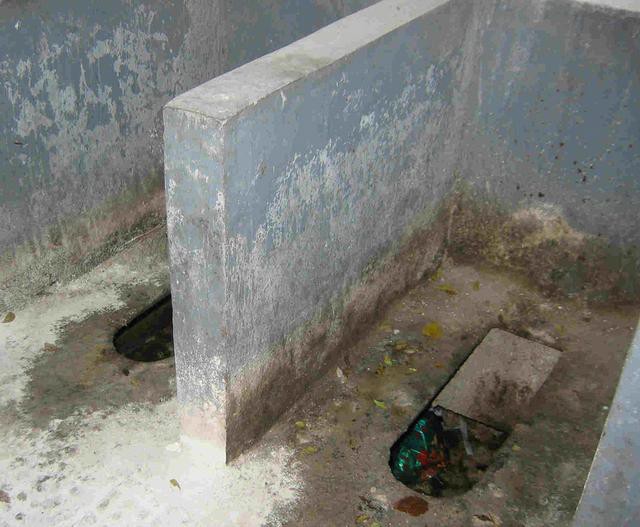
Toilets in Tonghua, China, by Dominic Rivard.
There’s a common thread running through a number of these truly shitty ideas around shit. To reduce water and paper waste requires people to adhere to ways of life that take us backwards in time. It compels people to return to patterns of labor and leisure (or the lack thereof) which are often sexist and in fact can actually aid in the greater spread of disease.
In the new world of shit, where even water is considered wasteful and people are expected to revert to some atavistic idea of a “natural way,” a call for more flush toilets and greater ease of use is looked upon as backwards and disrespectful to the planet.
In Zen Confidential, Shozan Jack Haubner, a practicing Zen monk, writes about staring at “dense, towering shitbergs,” the results of a failed composting experiment begun by the former head monk of his monastery. In essence, the idea of installing composting toilets came about without regard to the fact that the monastery was not legally permitted to grow anything on its land, which meant that the collected shit could not be used as “humanure” for the gardens.
As a result of the failure, to cut a long story short, it was left to Haubner, as the most junior monk, to spray down the shit until it turned into what a fellow resident called “poop soup.” Then they would pump it into a twenty-five-hundred gallon truck tanker, stuff it into plastic boxes, bake those in the sun to kill the pathogens — and then bury it six feet in the ground where it would rot uselessly. The job involved hazmat suits and being sprayed with shit.
Haubner is a self-described tall, white man who has chosen to be a monk, and who could theoretically leave the order whenever he wanted. In countries like Thailand and India, monks as well as Christian nuns and priests are often those who were given away to orders by desperately poor parents who simply couldn’t afford to keep them. Unlike Haubner, who can go on to write a humorous essay about his experience, these people are in effect indentured workers in religious orders.
The bigger issue evoked by Haubner’s story is that shit requires people who shit and people who take their shit away. In cities like New York and Chicago, the system is more or less automatic, with the sewer system taking on an automated function. But composting, if taken in the most basic form, as in the art gallery bucket I encountered or even the disastrous eco-experiment described by Haubner, can and does take on dangerous forms. Shit, it cannot be repeated often enough, is dangerous to your health. There’s a reason why your body needs to extrude it rather than recycle it into muscle and skin.
I bring that up because while Haubner’s story is funny, it’s easy to forget that there are situations like this which might feature involuntary and exploited labor. The business of shit removal is one handled only by the those considered the lowest of the low, and their lives are marked in literal and metaphorical grossness of shit.
If we are to truly reimagine the place of shit in our lives, we need to consider the harsh realities of who gets to shit in peace, and who gets to clean it up afterwards.
5. WHAT IS THIS SHIT ANYWAY
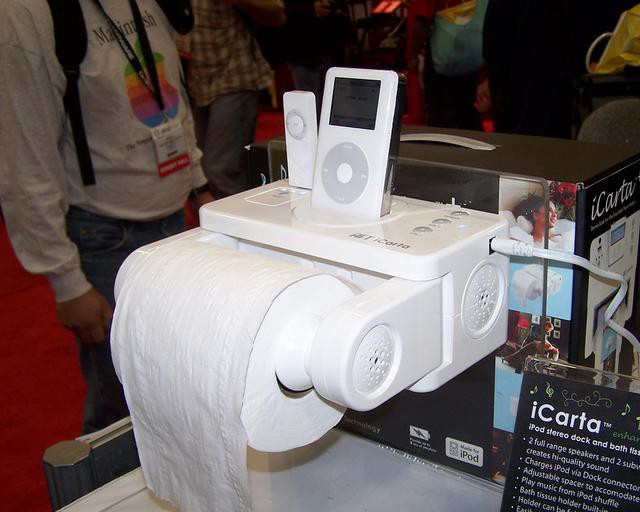
iCarta Stereo Dock and Bath Tissue Holder, by Rojer.
Even in cities where millions can shit without a second thought, shit has a particular hold on our imagination. We mock both shit and our own often panicked responses to it. Divine’s famous shit-eating turn in John Waters’ Pink Flamingos is an example of our simultaneous repulsion and fascination with shit. A recent viral video is for a product called “Poo-Pourri Before-You-Go Toilet Spray” with an impeccably dressed woman with a pronounced British accent praising the virtues of an item you spray to hide the odors.
Recently, this aversion took on a surreal turn when Melissa Gorga of “The Real Housewives of New Jersey” admonished readers of her advice book, Love Italian Style: The Secrets of My Hot and Happy Marriage, to never, ever let their husbands know that they shit.
Shit, for some, has had curative or life-extending properties. Martin Luther is reputed to have swallowed a spoonful of his own every day. Laporte writes that an 18th-century woman explicitly hired a young man to divest himself of his shit every night so that she might spread it on her face. That was apparently the secret to her astonishingly youthful appearance, which supposedly lasted her lifetime. The story might well be apocryphal — and the young man’s services may well have extended far beyond shitting, in a society where smearing shit on one’s face was less scandalous than fucking the help — but the existence of such stories reveals a lot about our complicated and contradictory relationship to our own waste material.
Shit is alternately considered silly and important. Oprah once spent an entire episode with Dr. Oz describing what one’s stool should look like (S-shaped, we were told, and of course the Big O. told her audience that hers were just perfect). A Taiwan-based restaurant chain, Modern Toilet, which recently opened its first U.S branch in Los Angeles, serves food in miniature toilet bowls, consumed while diners sit on toilet seats.
Shit’s complicated: The source of ageless beauty, as well as endless troves of humor and often a source of shame.
Unlike, say, garbage, shit is unique in that we make it ourselves, literally, in sufficient quantities and in messy piles. Unlike the millions of dead skin cells and hairs we shed regularly, it’s visible, often smelly and, to most of us, just plain gross. It’s also difficult to get rid of with tact and discretion in a public setting: There’s no wiping shit away with a napkin and disposing of it in a trash can.
In a time when shit is being reclaimed and held closer, and when people are increasingly voicing the idea that we should live with it, that particular fact seems especially important. As Rose George writes:
Eighty percent of the world’s illness is caused by fecal matter. A gram of feces can contain 10 million viruses, 1 million bacteria, 1,000 parasite cysts, and 100 worm eggs. Bacteria can be beneficial: the human body needs bacteria to function, and only 10 percent of cells in our body are actually human. Plenty are not. Small fecal particles can then contaminate water, food, cutlery, and shoes — and be ingested, drunk, or unwittingly eaten. One sanitation specialist has estimated that people who live in areas with inadequate sanitation ingest 10 grams of fecal matter every day.
6. THE SHIT’S PROGRESS
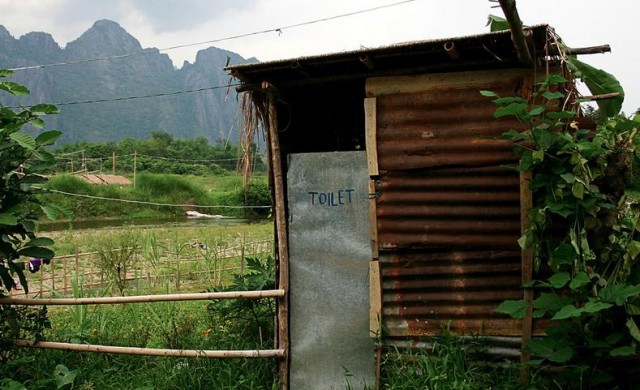
Toilet in Laos, by Petr & Bara Ruzicka.
In ancient times, civilizations (as described in standard narratives about history) like those of Mohenjo-daro and Harappa prided themselves on their elaborate sewage systems.
But as the centuries went by and the Industrial Revolution concentrated in cities, urban areas began to sway and crack — and stink vociferously — under the pressure of too much shit in one place.
The removal of excrement has literally transformed the landscape of cities. The most famous example is that of the Thames in London which, in the mid-1800s, earned the name The Great Stink. Diseases like cholera spread through the population and the city, already smoggy from pollution, stank so greatly that people could barely breathe in the air. New York City also had a cholera epidemic in the 1850s; the city’s population was just over half a million people and already in desperate need of a sewage system, which would be improved each decade since its creation and then again be immediately overwhelmed.
Chicago performed three engineering marvels to deal with its sewage. These included the reversal of an entire river. (This remains the source of much umbrage in Michigan, which periodically tries to reverse the reversal; inevitably anger and barely subdued Midwestern sarcasm ensue.)
But shit-filled water conditions still plague many parts of the world where shit literally lies in abundance everywhere, transmitting medieval diseases like cholera. The overcrowding of cities like Kolkata and Mumbai, which bear the burden of massive migrations from rural areas by people desperate to escape poverty or to simply survive, has meant the dispensing of formalities.
Perhaps the most shit-infused cinematic scene is the one in Slumdog Millionaire, where Jamal jumps into a cesspool of shit to escape an outhouse in order to get an autograph from a bemused Amitabh Bachchan. Bachchan is played by an actor in the film but in real life, he’s a megastar whose reach in Asia and parts of Europe exceeds that of Tom Cruise, so the idea of him being splattered by shit is redolent, as it were, with all kinds of metaphors.
Which is to say: Shit is different in different parts of the world. In the U.S. we have this nascent movement to install composting toilets everywhere, which means that there’s a movement to keep our shit closer to us. In much of the rest of the world, people are desperately trying to escape shit, and even a simple flush toilet — the kind that requires you to fill a bucket of water and slosh it down the toilet — is considered a mark of high progress. (Member organizations of the Sustainable Sanitation Alliance often combine these two concerns well, helping members build sustainable toilet facilities in places without running water.)
In the western traveller’s imaginary, the absence of places to shit paradoxically becomes the mark of a world-weary been-there-done-it sophistication. The history of shit follows a simple trajectory that fails to take into account the competing definitions and histories of modernity. There are two streams of modernity here, if we truly follow shit. One is conceived as a trajectory that has gone too far, and now needs to be reeled back in towards a privatized, neo-primitivist composting system. The other never began.
2.6 billion out of the 7 billion in the world don’t have sanitation. As Rose points out, this means they literally have nothing: not even a hole in the ground. Millions more, like the street urchins of Mumbai, have inadequate and dangerous systems which can barely be called “sanitation.”
Consider the difficulties of your everyday life if you had to wade through wet fields or even an idyllic garden to get to a leafy area to shit or to an outhouse to take a crap, and if you couldn’t simply flush it away with a quick movement of the hand but had to worry about the sanitary requirements of seeing that the shit didn’t simply turn into a disease-harboring pile or smear your clothes or return with you into the home.
Consider what your day would look like if you had to go in a bucket, constantly rake over your own shit and that of others, being careful to cover it with enough composting material so that it didn’t simply turn into, well, a pile of shit that, again, spread disease amongst everyone in your household.
For many millions of people, shit is not something you hold on to but rapidly want to get away from, as soon as you’re done. For the eager shit activists in cities like Chicago and New York, composting is a way to prove their fealty to the planet or their credibility.
It’s not that there aren’t sound ecological reasons to rethink the production and release of shit, or that we don’t need to consider alternatives. But the discourse of late has become altogether too smug and ignores the fact that what some people in the western hemisphere want to hold on to is also what many in the rest of the world spend their lives trying to get away from. Shit is more than a metaphysical exercise for most: it is a literal and physical site of denigration, a marker of the absolute opposite of the excess that eco-primitivists are trying to get us to embrace in almost literal ways.
In other words, shit is shit.
It’s time to stare into the toilet and the excremental hyperbole it tends to spawn, and to reconfigure a relationship to shit that’s not based on a kind of biological neo-primitivism. Shit lies at the nexus of competing visions of modernity.
7. THE SEXUAL POLITICS OF SHIT
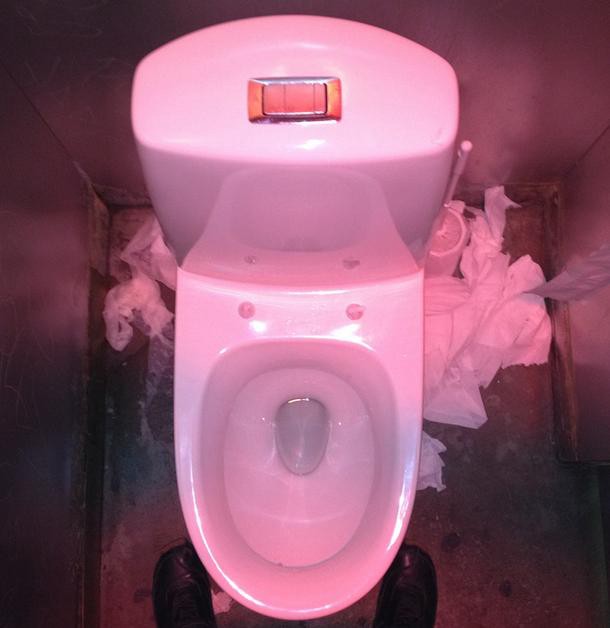
Toilet, by “dirtyboxface.”
Shit, like child-rearing, is also gendered. The Real Housewife and the misguided women who follow her example might well invite a host of infections because of the sexist stereotypes they perpetuate, but millions of women across the world are forced to hold it in because they simply can’t piss or defecate or during the daytime.
In The Origin of Feces, Waltner-Toews writes about a village in Mexico, where using the toilet was a completely different enterprise for the women. The men could shit and piss with impunity in the outdoors during daylight hours, but women ended up having to wait till nighttime, making their way past snakes and men. The same is true in India, where men can and do shit on roadsides. Often women go out at night, making themselves vulnerable to sexual and other kinds of assault.
For that matter, even the U.S lags behind many countries in providing clean, safe, and easily accessible public restroom facilities. Australia has an electronic National Public Toilet Map, documenting 14,000 public toilets; in America, businesses often violate the law by asserting there are no restrooms for their customers, much less non-customers.
The failure to do more is in part due to a large public distrust of, first, anything that might benefit the larger public good and a general refusal to think about how integral toilets are to human health. Among trans people, bathroom harassment and outright violence add more layers of anxieties to places that are already sites of gender surveillance and policing.
Shit is and very much needs to be considered alien to our bodies if lives are to be held valuable.
8. EATING SHIT
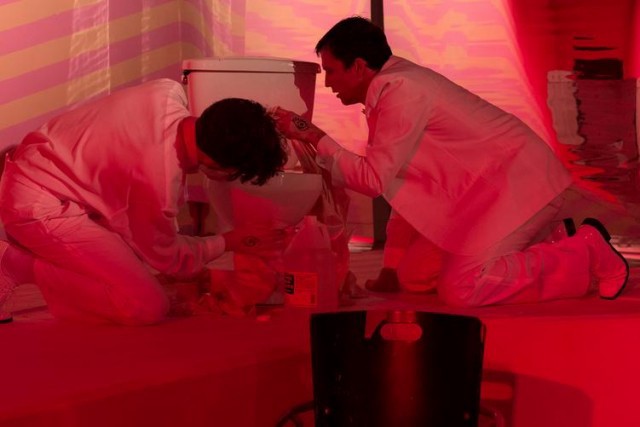
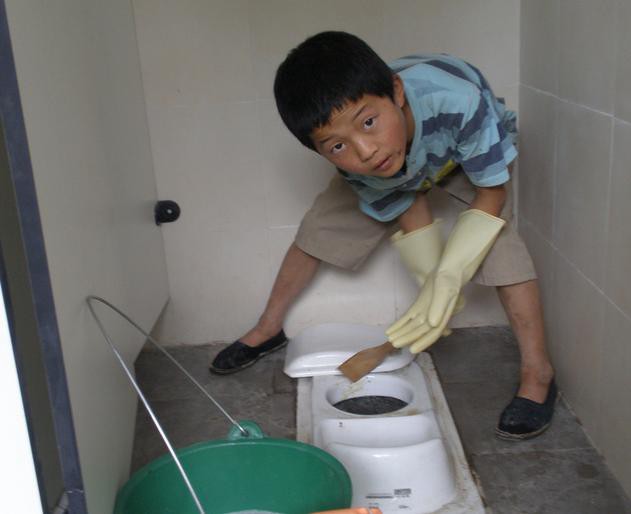
Top: toilet cleaning performance art, by BurnAway. Bottom: child in China cleans a toilet, by Sustainable Sanitation.
I was on a layover in Bombay while traveling back to Calcutta on a summer visit some years ago, and needed to use the public loo.
Once done, I discovered that there was no way to get rid of the shit. I stood there for a while, desperately wondering where the secret handle or switch might be — was this tawdry-looking bathroom somehow home to some incredibly sophisticated flushing mechanism that I couldn’t discern?
Finally, I emerged and looked around sheepishly. A sari-clad woman, her pallu wrapped around her head, smiled at me, clearly understanding the source of my shame. “Don’t worry,” she said in Hindi, “I’m going to go in and take care of it.” Then I saw the long brush and bucket in her hand. There were a few more women, all waiting in line not to use the loo but to step in after people were done to remove the remains.
The women were probably Dalits (formerly known, along with other groups, as “untouchables”). They are the lowest caste in India, a repository of centuries of horrifying stigma and violence. Despite post-Independence efforts to legislate change, Dalits are still banned from many public spaces and forced to engage in what Indian society, marked by intense hierarchies, deems the only fit work for them. Dalits are also routinely exploited, harassed, raped, beaten, and killed with impunity.
In this context, it’s not just that some people are designated as those who must do certain kinds of work, like taking out the trash or cleaning the streets, but that the work itself is considered shameful — this, in part explains the abundance of servants in India, in a country where many people still don’t do their own laundry.
Dalits’ position as the lowest form of human has meant that upper caste Hindus subject them to the worst forms of humiliations, effectively designed to put them in their place: In several recorded instances, Dalits have been forced to eat feces.
The Tamil writer Perumal Murugan is well-known for fiction and essays that explore the world of untouchables in India.
In a yet untranslated anthology of short works titled Shit Stories (Adayam Press, 2004), Murugan writes about several instances of the pervasiveness of shit and, by extension, the places where shit is deposited or collected, including the standard Indian toilet. In one passage, he describes it resembling “a skull with the danger crossbones… that has bared its palms” to the world.
Shit — particularly the shit of others — is real for millions in the world. Its sheer shitness cannot be wished away or made less corporeal by a discourse around shit which effectively locates the problem as one of too much shit being taken away when, for so many, the problem is that they are forced to live with and even consume, in so many different ways, the shit around them.
In India in the 70s and the 80s, almost every film was preceded by a short documentary on a socially relevant issue, a kind of PSA. One of these, I recall, was about the contamination of water supplies around the world and the encroaching ecological disasters that might overtake us. In a characteristically magisterial voice, the narrator intoned, “Soon, one city will be drinking the sewage of another.”
This did come to pass. The reality is that Detroit and Chicago, for instance, are in essence swilling each other’s shit and garbage in shared water. The reality is also that your water gets more or less cleaned based on who you are and where you live. Chicago is famous for its lakeshore — most of it is artificial, and if you live on the north side as I do, you get to enjoy the view and the cooler temperatures for a good portion of the year. (Chicagoans are masters of denial and refuse to acknowledge that the lake is really much too cold for nearly nine months of the year, but that’s another story). But the south side of the city, populated mostly by African Americans and marked by the kind of economic devastation that’s never referenced in our pretty postcards, frequently has its shores shut down because of bacterial infestation.
Population densities in urban areas have polluted parts of the world’s seas and lakes. Sewer systems are overwhelmed: in New York City, about 30 billion gallons of untreated sewage and storm water overflows the current system each year. The solution so far has been to treat drinking water with chemicals; a good minority of Americans receive chloramine-treated water, which is fine, unless you want to fill a fish tank. In this context, it makes sense to think about toilets differently.
Measures like cloth napkins or diaper-less child-raising or composting toilets fail to take into account the structural elements at play. The problem is not that people are using flush toilets. The problem is that we exist in a system that willfully exploits particular people and environments, compelling them to move to areas of high concentration. The resulting problems are compounded by systemic economic exploitation which refuses to allow specific groups of people access to the basics of life. Those basics include flush toilets and basic sanitation.
Today there are ambitious plans amongst some to make even apartment complexes install composting toilets. Such plans are ridiculous in cities where vast areas are underserved to such a degree that they lack a sustained public school structure, grocery stores, or even enough habitable housing.
As with so many eco-primitivist and, indeed, so many ecological solutions, the response to too much shit in the oceans has largely been one that ignores the material realities of those who actually live closest to it. A more ideal solution would be to first find ways of creating economic systems that don’t drive so many millions to desperate living conditions, and to begin to end the massive exploitation that ensures the economic disparities that are in fact exemplified by so many of the eco-solutions.
Much of the failure of current ecological solutions to shit can be located in the lingering suspicion not just around things like toilets, but around the very concept of urban living. The logic of eco-primitivism, exemplified by the ridiculous and unrealistic lifestyles of “no impact” people, is built on calcified ideas about what our “natural” impulses are. By this logic, people are supposedly unsuited to city life, and the only solution is to create habitats which replicate “nature” as closely as possible. We are constantly admonished to only eat local, and to recreate some vaguely arboreal environment in city apartments.
In the meantime, we ignore the fact that the problems of cities like Chicago are not rooted in the fact that people don’t eat locally, but that so many have few places to obtain food at all. We don’t need to eradicate cities, which are perfectly fine and sustainable and even immensely liberatory spaces for millions: We need to find ways to make them better. A new wave of green-roof buildings and other measures has taken root, but cities remain one of the most unequal, both economically and racially, in systems intentionally made that way. (“Only three of New York’s 14 treatment plants operate in communities that aren’t majority black or Latino.”) Meanwhile, their basic infrastructures, like roads and bridges, are literally crumbling away to pieces.
For now, we live in a coprophagic economy. Many of us are, in mediated ways, eating each other’s shit. In some cases, as with the Dalits, this borders on the brutally literal. It’s also literal in the most supposedly advanced American cities where economic and racialized inequalities can mean that some people’s water supply is badly contaminated while others can afford systems that cleanse and reuse their water in “green” environments.
In this shit — and shitty — economy, shit is implicated in a dense network of social, political, and economic relations between people. Whether you shit or whether you clean up shit, and how those functions are marked in material realities by the instruments in which you shit or with which you clean, defines your relationship to a fragile order. Some of us eat, shit, and die. Some of us eat shit and die.
Yasmin Nair lives and writes in Uptown, Chicago. She is, with Ryan Conrad, a co-founder of the editorial collective Against Equality and Volunteer Policy director of Gender JUST. She’s grateful to all her friends for putting up with a lot of awful shit puns for many weeks, to Gautham Reddy for sharing his ongoing dissertation work on versions and visions of modernity, to Aniruddhan Vasudevan for so generously sharing and translating the work of Perumal Murugan, and to Doug Henwood for much commiseration about neo-primitivism